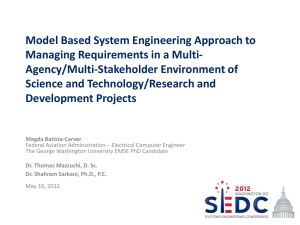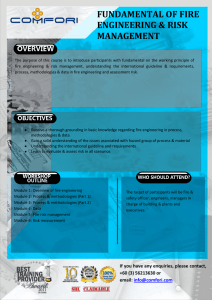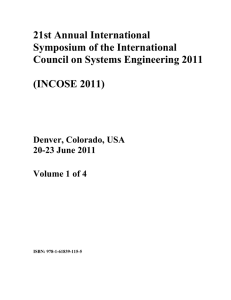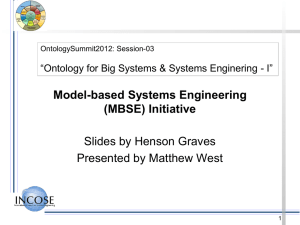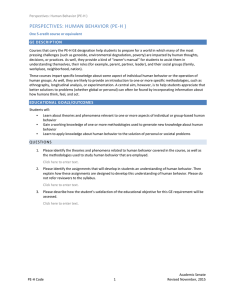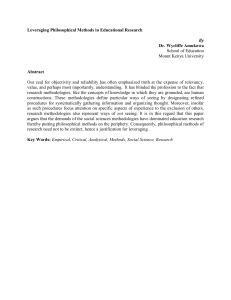A Brief View of Model Based Systems Engineering Methodologies
advertisement
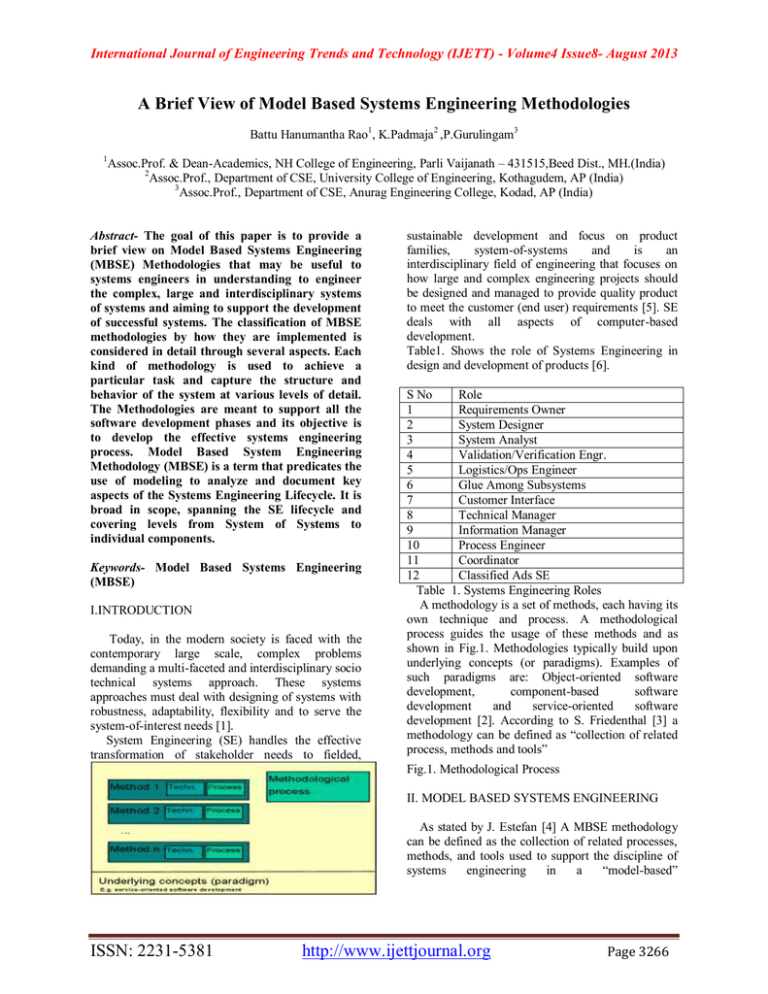
International Journal of Engineering Trends and Technology (IJETT) - Volume4 Issue8- August 2013 A Brief View of Model Based Systems Engineering Methodologies Battu Hanumantha Rao1, K.Padmaja2 ,P.Gurulingam3 1 Assoc.Prof. & Dean-Academics, NH College of Engineering, Parli Vaijanath – 431515,Beed Dist., MH.(India) 2 Assoc.Prof., Department of CSE, University College of Engineering, Kothagudem, AP (India) 3 Assoc.Prof., Department of CSE, Anurag Engineering College, Kodad, AP (India) Abstract- The goal of this paper is to provide a brief view on Model Based Systems Engineering (MBSE) Methodologies that may be useful to systems engineers in understanding to engineer the complex, large and interdisciplinary systems of systems and aiming to support the development of successful systems. The classification of MBSE methodologies by how they are implemented is considered in detail through several aspects. Each kind of methodology is used to achieve a particular task and capture the structure and behavior of the system at various levels of detail. The Methodologies are meant to support all the software development phases and its objective is to develop the effective systems engineering process. Model Based System Engineering Methodology (MBSE) is a term that predicates the use of modeling to analyze and document key aspects of the Systems Engineering Lifecycle. It is broad in scope, spanning the SE lifecycle and covering levels from System of Systems to individual components. Keywords- Model Based Systems Engineering (MBSE) I.INTRODUCTION Today, in the modern society is faced with the contemporary large scale, complex problems demanding a multi-faceted and interdisciplinary socio technical systems approach. These systems approaches must deal with designing of systems with robustness, adaptability, flexibility and to serve the system-of-interest needs [1]. System Engineering (SE) handles the effective transformation of stakeholder needs to fielded, sustainable development and focus on product families, system-of-systems and is an interdisciplinary field of engineering that focuses on how large and complex engineering projects should be designed and managed to provide quality product to meet the customer (end user) requirements [5]. SE deals with all aspects of computer-based development. Table1. Shows the role of Systems Engineering in design and development of products [6]. S No Role 1 Requirements Owner 2 System Designer 3 System Analyst 4 Validation/Verification Engr. 5 Logistics/Ops Engineer 6 Glue Among Subsystems 7 Customer Interface 8 Technical Manager 9 Information Manager 10 Process Engineer 11 Coordinator 12 Classified Ads SE Table 1. Systems Engineering Roles A methodology is a set of methods, each having its own technique and process. A methodological process guides the usage of these methods and as shown in Fig.1. Methodologies typically build upon underlying concepts (or paradigms). Examples of such paradigms are: Object-oriented software development, component-based software development and service-oriented software development [2]. According to S. Friedenthal [3] a methodology can be defined as “collection of related process, methods and tools” Fig.1. Methodological Process II. MODEL BASED SYSTEMS ENGINEERING As stated by J. Estefan [4] A MBSE methodology can be defined as the collection of related processes, methods, and tools used to support the discipline of systems engineering in a “model-based” ISSN: 2231-5381 http://www.ijettjournal.org Page 3266 International Journal of Engineering Trends and Technology (IJETT) - Volume4 Issue8- August 2013 environment. It can Formalizes the practice of systems engineering through the use of models. In the field of system engineering one of the most rising, up-coming and significant principle in software development is to be MBSE methodology. Model Driven/Based Development Method uses the activities associated with modeling to drive the whole development process. The Need of MBSE is to improve quality & communications, increase productivity, reduce complexity/risks in software development. Earlier to model based approaches organizations may follow document centric approach for specifications, interface requirements, analysis and trade-offs, test plan etc. In order to prepare deliverable documents might consume enormous time (time complexity). Chances of getting errors (error-prone). Keep in view of this, organizations would like to start creating models as adjuncts to existing document centric approaches. III. MODEL BASED SYSTEM ENGINEERING METHODOLOGIES The Embedded Computer System Analysis Modeling Methodology (ECSAM), Model Based Architecture and System Engineering (MBASE), The Harmony SE, Object Oriented System Engineering Methodology (OOSEM), Rational Unified System Engineering (RUP SE), Vitech MBSE Methodology , Objet Process Methodology(OPM), LITHE Methodology are the existing notable MBSE methodologies titled in [4] and [7]. All these methodologies are classified based on the principles/approaches, Control flow, State Transition, Architecture in design and development of systems engineering process. By analyzing all these existing methodologies, it is found that the primary objective is to deliver an effective model for SE process and each methodology is designed on a particular principle to meet the end user requirements and to satisfy the various stakeholders. A. The Embedded Computer System Analysis Modeling Methodology (ECSAM) Embedded Computer System Analysis and Modeling (ECSAM) methodology from Lavi and Kudish was developed in part at Israel Aircraft Industries for the analysis and design of complex reactive embedded systems and software. It is requirement engineering and one of the modeling ISSN: 2231-5381 methods for computer-based systems (CBS).The primary objective of this model is to derive system and software requirements systematically. This modeling technique not only used for the analysis of the system and also at lower-level subsystems. This method helps the developer in derivation of requirements and systematic allocation to and association with models elements at various levels of the systems conceptual model and systematic analysis and modeling of systems being designed and developed. The Method support systematic objectbased decomposition technique of the proposed system into conceptual. ESCAM provides for systematic analysis of the interaction of a system with its operational environments and provides a procedure for systematic identification of characteristics needed by the system to fulfill its missions. ESCAM was the prime motive was the development of state chart technology developed by Prof. David Harel as part of the method [9] & [10]. B. Model Based Architecture and System Engineering (MBASE) Model Based Architecture and System Engineering (MBASE) is from Prof. Barry Bohem and Prof. Dan Port . It is an approach to the development of software systems that integrates the system’s process (tasks, activities, milestones), product (architecture, requirements, source code etc.,) property (cost, schedule, performance, dependability) and success (stakeholder win-win) models. The artifacts of MBASE are Operational Concept Description, System and Software Requirements Definition, System and Software Architecture Description, Life Cycle Plan, Feasibility Rationale Description, Construction, Transition, Support plans and reports Risk-driven prototypes. This model was smart to reduce the huge amount of efforts in documentation. Consequently, Lean MBASE, which is a light-weight software process framework that helps teams identify the high-value activities and helps balance the workload of a development, is being used in the software engineering course. C. The Harmony SE The Harmony SE is from IBM Telelogic; it is the module of integrated systems and software development process is known as Harmony. The http://www.ijettjournal.org Page 3267 International Journal of Engineering Trends and Technology (IJETT) - Volume4 Issue8- August 2013 purpose of this methodology was designed to be vendor neutral and tool neutral. Harmony-SE follows service-request driven modeling approach along with OMG SysML artifacts to achieve the objectives of requirement analysis, architecture analysis and design concepts in SE process. The process somewhat replicates” Vee” life cycle development. Even it is designed to be tool neutral IBM offers tool support via Telelogic Rhapsody and Telelogic TAU modeldriven development environments. The Vitech Methodology is from Vitech Corporation, it implements the principles of both concurrent and incremental development approaches (“onion model”). The objectives of this methodology are to provide structured, common, explicit context free language for technical communication. Hence it is strongly recommends System Definition Language and it is supported by CORE product suite. G. Jet Propulsion Laboratory State Analysis (JPL SA) D. The Object Oriented System Engineering (OOSE) The OOSE Methodology is from INCOSE and it is a scenario driven approach, it follows Vee model and includes object oriented principles i.e Top-down approach with object oriented principles. Main objectives of this model are to support system-level reuse & design evolution, To integrate other engineering methods with object oriented software, hardware, To specify complex system captures requirement analysis and design information. To achieve these objectives, OOSEM has includes the activities of analysis of stakeholders needs , requirements classification, definition of the logical architecture ,synthesis of candidate allocate architectures, optimization and alternative evaluation verification and validation (V&V) of the system. This methodology can be supported by the tools of OMG SysML and the associated modeling language is SysML. E. The RUP SE The RUP SE is from IBM and it is a derivative of the Rational Unified Process (RUP), RUP includes both process framework and product from IBM Rational. For iterative and incremental development process RUP follows spiral model and includes object oriented principles. The objective of this method is to assist the organization to reduce risks, reduce time complexity, and improve quality, of systems they innovate. To achieve these objectives RUP SE has includes inception, elaboration, construction, transition that are detailed through use-case flow design activities. The allied modeling languages are UML and SysML and the methodology is supported by RUP SE plug-in Rational Method Composer (RMC) from IBM. F. The Vitech ISSN: 2231-5381 Jet Propulsion Laboratory State Analysis (JPL SA) method was developed by Jet Propulsion Laboratory (JET) at California Institute of Technology to achieve space missions. The method defines a process for identifying and modeling the states of the physical system and their relationships with other states, the form of knowledge and control objectives against these states, and the planning, coordination, execution, and response mechanisms by which these objectives can be achieved in a reliable manner [11]. The basic functionality of state analysis is to partition between control system and the system under control. This method minimizes the breaks in software implementations of systems engineering requirements. The method begins with a model of the behavior of the system to be controlled; including any sensors or actuators needed to interact with this system, and then proceeds with models of needed control system capability. It is an iterative process for modeling and state discovery. The method includes state based behavioral modeling and state-based software design. The Tools used in this method is State Transition Tools (State Transition diagram, Elaboration diagram etc.) H. Object Process Methodology (OPM): Object Process Methodology from Prof. Dori and his team defines as a formal paradigm to systems development, lifecycle support, and evolution [13]. OPM formally defines , A Object is a thing that exists, A Process means is a pattern of transformation that an object undergoes, A state is situation to an object can be at [4] .It merges the object-oriented (Object Process Diagrams-OPD) and the process- http://www.ijettjournal.org Page 3268 International Journal of Engineering Trends and Technology (IJETT) - Volume4 Issue8- August 2013 oriented (Object Process Languages –OPL) approaches. The method can be used to model both natural systems and artificial systems. i.e. OPM is a holistic systems paradigm. It can be used to document functions of system architecture. It manages complexity trough abstraction mechanism. OPM-based development supported by OPCAT software environment. feedback and rousing the utilization of a coherent system model. This methodology includes the principles of SIMILAR process [8] and this method is a combined approach of three methods (OOSEM, RUP SE and OPM) to meet the requirements. SysML and OPD/OPL modeling languages are used in LITHE Methodology and includes graphical tool namely GRAPHITE (GRAPHIcal Tool for stackEholders) I. LITHE IV. MBSE Methodologies at a Glance The methodologies noted above have some limitations in terms of utilization of modeling languages and inclusion of HSI concerns. Hence, there is a need of another methodology to achieve these limitations. These limitations are conquered with LITHE Methodology. The objective of this methodology is to reduce the complexity and intricacy and to emphasize the agile principles such as rapid response, continuous communication, The MBSE Methodologies discussed above are formatted in a tabular form for better understanding to the system engineers for effective design and development of successful systems. Table 2 shows the various MBSE methodologies implemented approaches, modeling tools supported by the methodology and its objectives etc. Name of the MBSE Methodology Methodology from Implemented Principle/Approach 1 ECSAM Prof. Lavi & Kudish-Isreal Air Craft Industries Object-Based decomposition approach SADT 2 MBASE Prof. B. Bohem &Dan Port Integration approach FFBD 3 Harmony –SE IBM Top-Down approach Tool neutral but IBM offers tool support via Telelogic Rhapsody 4 OOSEM INCOSE Object Oriented Principles Top-Down approach Scenario-driven approach SysML To support systemlevel reuse & design evolution 5 RUP SE IBM UML, SysML To assist organization reduce risks Sno Supported Tools Object Oriented Principles 6 Vitech Vitech Corp. Incremental approach Concurrent Development 7 JPL SA JPL Behavioral approach ISSN: 2231-5381 Modeling Modeling SDL,FFBD State Transition http://www.ijettjournal.org Objectives To derive system and software requirements systematically To reduce huge amount of efforts in documentation It was designed to be vendor neutral and tool neutral the to To provide context free language for technical communication To minimize the breaks in software Page 3269 International Journal of Engineering Trends and Technology (IJETT) - Volume4 Issue8- August 2013 implementations 8 OPM Prof. Dov Dori Object Oriented Principles .Holistic paradigm OPD,OPL 9 LITHE Prof. Ana Ramos Object Oriented Principles Top-Down approach GRAPHITE OPD/OPL SysML Lusa To document functions of system architecture To reduce complexity and intricacy of base methods Table. 2. MBSE Methodologies at a Glance V. CONCLUSION This brief view on MBSE Methodologies provides a coherent way to know about methodologies and to consider their properties and priorities for systems engineers in understanding to engineer the complex, large and interdisciplinary systems of systems and aiming to support the development of successful systems. The methods discussed above specify HOW to execute a process to develop a system model. According to authors point of view the existing methods are immature and each method is designed to achieve a specific objective only and all these methodologies except LITHE are particularly focused on the implementation of the concept and development phases of the SE process where LITHE is particularly designed with Human System Integration (HSI) even though this method is efficient and logical , there is a less proof of values in the real world. Hence the authors says that there is high tendency for research in this aspect and authors conclude that there is a need of standard MBSE methodology which satisfy the stake holders expectations and aiming to support for the development of successful systems . REFERENCES [1]. Donna H Rodes “Addressing System Engineering challenges through collaborative research”, in SEARI-Systems Engineering Advancement Research Initiative. Cambridge, MA; MIT press, 2008. [2]. Arne-Jørgen Berre, Brian Elvesæter “Model Based System Development” Version 1.00 May 2, 2008 [3]. S. Friedenthal, A. Moore and R. Steiner, A Practical Guide to SysML. The Systems Modeling Language. Burlington MA; OMG Press, 2008. ISSN: 2231-5381 [4]. J. Estefan, “ MBSE methodology survey”, INSIGHT-INCOSE J., vol 12, no. 4,pp, 16-18, Apr 2009. [5]. D. Rhodes “Addressing systems engineering challenges through collaborative research”, in SEARI-Systems Engineering Advanced Research Initiative. Cambridge, MA: MIT Press, 2008. [6]. Sarah A. Sheard “Twelve Systems Engineering Roles” 1996 Software Productivity Consortium, NRP, Inc., http://www.software.org. All Rights Reserved. Used with Permission..8 Published in the Proceedings of the INCOSE Sixth Annual International Symposium (Boston, Massachusetts, USA). [7]. Ana Lusa Ramos “LITHE: An Agile Methodology for Human-Centric Model-Based Systems Engineering” IEEE Transactions on Systems, Man, Cybernetics: Systems Vol.43, No.3, May 2013. [8].A. Ramos, J Ferreira and J Brace, “Revisiting the SIMILAR process to engineer the contemporary systems”, J. Syst.Sci. Syst. Eng., Vol. 19, no.3, pp. 321-350, sep. 2010. [9].Jonah Z Lavi and Joseph Kudesh”System Modeling and Requirement specification using ECSAM: an Analysis Method for Embedded and Computer Based Systems” Dorset House Publishing Company, Inc.: New York, NY, 2004. [10].Jonah Z. Lavi and Joseph Kudish, “Systems Modeling & Requirements Specification Using ECSAM: An Analysis Method for Embedded & Computer-Based Systems,” Innovations in Systems and Software Engineering, Vol. 1, No. 2, Springer: London, England, pp. 100-115, Sept. 2005. [11]. Charles E. Dickerson and Dimitri Mavris “A Brief History of Models and Model Based Systems Engineering and the Case for Relational Orientation “IEEE Systems Journal. [12]. C. Haskins, K. Forsberg, and M. Krueger, Eds., Systems Engineering Handbook—A Guide for System Life Cycle Processes and Activities. San Diego, CA: INCOSE, 2007. http://www.ijettjournal.org Page 3270 International Journal of Engineering Trends and Technology (IJETT) - Volume4 Issue8- August 2013 [13]. Dori, Dov, Object-Process Methodology: A Holistic Systems Paradigm, Springer-Verlag: Berlin Heidelberg, Germany, 2002. [14]. B. Sauser, J. Boardman, and D. Verma, “Systomics: Toward a biology of system of systems,” IEEE Trans. Syst., Man, Cybern. A, Syst. Humans, vol. 40, no. 4, pp. 803–814, Jul. 2010. [15]. Prof. Barry Boehm Evaluation of Systems Engineering Methods, Processes and Tools on Department of Defense and Intelligence Community Programs-December 2009. [16]. Barclay Brown, IBM Rational Model-based systems engineering: Revolution or evolution? IBM Software Thought Leadership White Paper December 2011 [17]. Dov Dori Technion, Israel; MIT, USA ObjectProcess Methodology and Its Application to the Visual Semantic Web [18]. L. Militello, C. Dominguez, G. Lintern, and G. Klein, “The role of cognitive systems engineering in the systems engineering design process,” Syst .Eng. vol. 13, no. 3, pp. 261–273, Aug. 2010. 1. Battu Hanumantha Rao received M.Sc and M.Tech degrees in Computer Science and Engineering and also received MBA degree in HR. He is also a research scholar at the Department of Computer Science and Engineering, Acharya Nagarjuna University, Guntur (AP). He is currently an Associate Professor in Computer Science and Engineering Department with the NH College of Engineering, Parli Vaijanath, Maharashtra, Where he is the Dean of the Institution. He worked in various positions in Engineering colleges and P.G. Institutions. Mr. Rao is having around 13 years of experience in teaching and managing educational institutions. His areas of interest are Software Engineering, Computer Networks and Operating Systems . 2. Katta Padmaja is currently working an Associate Professor and Head of the Department of Computer Science and Engineering at University College of Engineering, Kothagudem (AP).She received M.Tech degree in Computer Science and Engineering and also received MCA and M.Sc degrees. Her research interests are at the area of Software Engineering and Data Mining 3. P. Gurulingam received B.E and M.Tech degrees in Computer Science and Engineering. He is currently an Associate Professor in Computer Science and Engineering Department at Anurag College of Engineering, Kodad (AP). He is having around 15 years of teaching experience. His research interests are at the area of Computer Networks and Software Engineering. ISSN: 2231-5381 http://www.ijettjournal.org Page 3271
